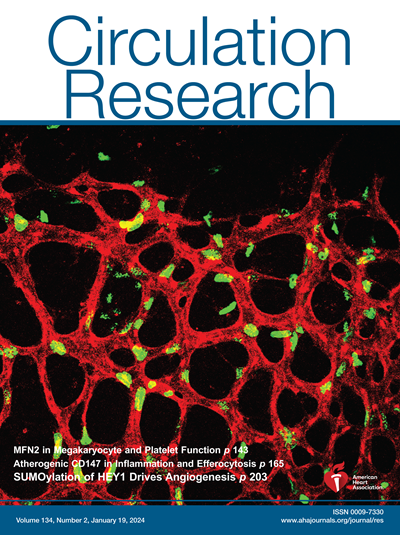Ferroptosis Mediated Inflammation Promotes Pulmonary Hypertension.
IF 16.5
1区 医学
Q1 CARDIAC & CARDIOVASCULAR SYSTEMS
引用次数: 0
Abstract
BACKGROUND Mitochondrial dysfunction, characterized by impaired lipid metabolism and heightened reactive oxygen species generation, results in lipid peroxidation and ferroptosis. Ferroptosis is an inflammatory mode of cell death that promotes complement activation and macrophage recruitment. In pulmonary arterial hypertension (PAH), pulmonary arterial endothelial cells exhibit cellular phenotypes that promote ferroptosis. Moreover, there is ectopic complement deposition and inflammatory macrophage accumulation in the pulmonary vasculature. However, the effects of ferroptosis inhibition on these pathogenic mechanisms and the cellular landscape of the pulmonary vasculature are incompletely defined. METHODS Multiomics and physiological analyses evaluated how ferroptosis inhibition-modulated preclinical PAH. The impact of adeno-associated virus 1-mediated expression of the proferroptotic protein ACSL (acyl-CoA synthetase long-chain family member) 4 on PAH was determined, and a genetic association study in humans further probed the relationship between ferroptosis and pulmonary hypertension. RESULTS Ferrostatin-1, a small-molecule ferroptosis inhibitor, mitigated PAH severity in monocrotaline rats. RNA-sequencing and proteomics analyses demonstrated that ferroptosis was associated with PAH severity. RNA-sequencing, proteomics, and confocal microscopy revealed that complement activation and proinflammatory cytokines/chemokines were suppressed by ferrostatin-1. In addition, ferrostatin-1 combatted changes in endothelial, smooth muscle, and interstitial macrophage abundance and gene activation patterns as revealed by deconvolution RNA-sequencing. Ferroptotic pulmonary arterial endothelial cell damage-associated molecular patterns restructured the transcriptomic signature and mitochondrial morphology, promoted the proliferation of pulmonary artery smooth muscle cells, and created a proinflammatory phenotype in monocytes in vitro. Adeno-associated virus 1-Acsl4 induced an inflammatory PAH phenotype in rats. Finally, single-nucleotide polymorphisms in 6 ferroptosis genes identified a potential link between ferroptosis and pulmonary hypertension severity in the Vanderbilt BioVU repository. CONCLUSIONS Ferroptosis promotes PAH through metabolic and inflammatory mechanisms in the pulmonary vasculature.铁蛋白沉积介导的炎症促进肺动脉高压
背景线粒体功能障碍的特点是脂质代谢受损和活性氧生成增加,从而导致脂质过氧化和铁中毒。铁蛋白沉积是一种炎症性细胞死亡模式,可促进补体激活和巨噬细胞募集。在肺动脉高压(PAH)患者中,肺动脉内皮细胞表现出促进铁蛋白沉积的细胞表型。此外,肺血管中还存在异位补体沉积和炎性巨噬细胞聚集。方法多组学和生理学分析评估了抑制铁蛋白沉积对临床前 PAH 的调节作用。确定了腺相关病毒 1 介导的高铁蛋白 ACSL(酰基-CoA 合成酶长链家族成员)4 的表达对 PAH 的影响,一项人类遗传关联研究进一步探究了高铁与肺动脉高压之间的关系。结果高铁素-1(一种小分子高铁抑制剂)减轻了单克隆大鼠 PAH 的严重程度。RNA测序和蛋白质组学分析表明,高铁血症与 PAH 的严重程度有关。RNA测序、蛋白质组学和共聚焦显微镜显示,铁前列素-1抑制了补体激活和促炎细胞因子/趋化因子。此外,铁前列素-1 还能抑制内皮、平滑肌和间质巨噬细胞丰度的变化以及解旋 RNA 序列显示的基因激活模式。铁氧体肺动脉内皮细胞损伤相关分子模式重组了转录组特征和线粒体形态,促进了肺动脉平滑肌细胞的增殖,并在体外形成了单核细胞的促炎表型。腺相关病毒 1-Acsl4 诱导了大鼠的炎性 PAH 表型。最后,在范德比尔特 BioVU 储存库中,6 个铁变态反应基因的单核苷酸多态性确定了铁变态反应与肺动脉高压严重程度之间的潜在联系。
本文章由计算机程序翻译,如有差异,请以英文原文为准。
求助全文
约1分钟内获得全文
求助全文
来源期刊

Circulation research
医学-外周血管病
CiteScore
29.60
自引率
2.00%
发文量
535
审稿时长
3-6 weeks
期刊介绍:
Circulation Research is a peer-reviewed journal that serves as a forum for the highest quality research in basic cardiovascular biology. The journal publishes studies that utilize state-of-the-art approaches to investigate mechanisms of human disease, as well as translational and clinical research that provide fundamental insights into the basis of disease and the mechanism of therapies.
Circulation Research has a broad audience that includes clinical and academic cardiologists, basic cardiovascular scientists, physiologists, cellular and molecular biologists, and cardiovascular pharmacologists. The journal aims to advance the understanding of cardiovascular biology and disease by disseminating cutting-edge research to these diverse communities.
In terms of indexing, Circulation Research is included in several prominent scientific databases, including BIOSIS, CAB Abstracts, Chemical Abstracts, Current Contents, EMBASE, and MEDLINE. This ensures that the journal's articles are easily discoverable and accessible to researchers in the field.
Overall, Circulation Research is a reputable publication that attracts high-quality research and provides a platform for the dissemination of important findings in basic cardiovascular biology and its translational and clinical applications.
 求助内容:
求助内容: 应助结果提醒方式:
应助结果提醒方式:


